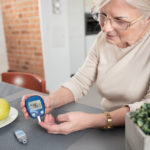By Bonnie Jenkins, Advanced Natural Wellness
As headaches go, migraines are in a league all on their own. Affecting three times as many women as men, they are far more debilitating than the more common tension headaches. To make matters worse, research suggests that for some sufferers, serious health consequences may be part of the migraine package.
A typical migraine produces unbearable, throbbing pain on one side of the head that lasts from a few hours to days. It can also create sensitivity to light and sound, and trigger nausea and vomiting. About 20 percent of the estimated 25 to 30 million migraine sufferers in the U.S. also experience “aura” – a disturbance in vision that precedes an attack.
Auras often consist of brightly colored or blinking light, blurred vision, blind spots or zigzag lines in your field of vision. While all migraines cause suffering to those who get them, it’s migraines with aura that appear to threaten health the most.
Head and Heart
One Harvard study examined the incidence of stroke in a group of nearly 40,000 women age 45 and older for nine years. The results? Women who experienced aura were nearly twice as likely to suffer ischemic strokes, the kind caused by clogged blood vessels to the brain. Migraines without aura posed no such risk.
A later study by the same researchers at Harvard revealed similar links between aura and other cardiovascular diseases. Migraines with aura almost doubled the chance for heart disease, heart attack and angina in nearly 28,000 middle-aged and older people compared to people suffering from aura-free migraines and no migraines at all.
Open your arteries, improve blood flow for a new health miracle...
Did you know your circulatory system has over 60,000 miles of arteries, veins and other blood vessels, if stretched end to end?
But as you age, your blood vessels undergo changes, which may cause them to stiffen, thicken and get clogged.
GOOD NEWS! Doctors have now identified a “Miracle Molecule” inside your arteries that helps OPEN your arteries and IMPROVE blood flow.
It’s what Dr. Valentin Fuster calls it, "One of the most important discoveries in the history of cardiovascular medicine."To you, that means...
- Healthy blood pressure
- Sharper mind and memory
- Skyrocketing energy and muscular strength
- Increased pleasure and passion in the bedroom
- Improved circulation to every cell and organ in your body
Go here to discover a new natural way to significantly boost the levels of this miracle molecule in YOUR body NOW!
Experts aren’t sure why aura increases the risk of cardiovascular disease. Some suggest it’s genetic. Australian and New Zealand researchers recently found that a genetic mutation that causes elevated blood levels of homocysteine is more common among people who experience migraines with aura than those without aura. High levels of homocysteine are associated with a greater likelihood of stroke and heart attack.
But even aura-free migraines may carry some risk. In a recent study in men, those who suffered migraines – with or without aura – were 42 percent more likely to have a heart attack. And new research in animals suggests that migraines may deprive brain cells of oxygen, causing brain damage.
Tame the Triggers
Although no one really knows what causes migraines, understanding what triggers them is more than half the battle. Many experts recommend keeping track of the foods you eat and particularly stressful situations for a month to try to pin down what triggers or exacerbates your migraines.
The most common triggers are foods, especially foods containing caffeine or tyramine. Tyramine is found in red wine, avocados, overripe bananas, aged cheese and chocolate, among other foods.Tannins are another compound that can spark a migraine and are most abundant in apple juice, blackberries, coffee, tea, chocolate and red wine.
But food isn’t the only culprit. Stress, lack of sleep, bright light, watching T.V., hormone fluctuations, odors, the weather and chemical sensitivities can also bring on a migraine. Identifying what is at the root of your pain can help you avoid triggers and lessen the frequency or severity of your migraines.
Natural Relief
Tracking your triggers isn’t the only way to master migraine misery. Magnesium is one of the most promising nutrients in headache research. Naturally found in soybeans, whole grains, nuts, seeds, vegetables and fish, this mineral is necessary for healthy muscle, nerve and blood vessel tone.
The World's Quickest Solution for Ending Prostate and Urinary Misery
This has recently been revealed to be one of the only real breakthroughs in prostate health.
The seeds of a strange fruit (sometimes called "Chinese Apples") hold powerful phytonutrients that are a revolution in prostate health.
In fact, UCLA and Veterans Administration research have now proved this to be true.
Not only that, but it may be the worlds quickest solution for ending prostate misery.
Simply stated, these phytonutrients represent a huge step beyond beta sitosterol, saw palmetto, and other phytosterols alone.
Simply click HERE if you want to have fast prostate relief...restful, uninterrupted sleep...no more constant "urges to go"...enhanced virility...and optimal prostate support for life.
Magnesium works by preventing blood vessel spasms and regulating pain receptors. In a German study of 81 migraine patients, 42 percent of subjects taking supplemental magnesium reduced the duration and intensity of migraine attacks, as well as their reliance on medications to control migraines. Try taking 200 mg. two or three times per day to help keep migraines at bay. To make your magnesium even more effective, combine it with vitamin B6. Vitamin B6 increases the amount of magnesium that can enter cells.
On the herbal front, feverfew slows the production of inflammatory compounds and helps maintain proper blood vessel tone. In a small study, migraine sufferers were given a combination of feverfew and white willow (a natural pain reliever) twice a day for 12 weeks. By the end of the study, migraine frequency had dropped by nearly 62 percent. The migraines that did occur were 39 percent less intense and didn’t last nearly as long as they did at the beginning of the study.
There’s just one cavat when it comes to feverfew – you must take it daily. It won’t work once a migraine sets in. Studies suggest that taking standardized feverfew leaf extracts that supply a minimum of 250 mcg. of parthenolide per day is most effective. Just be aware that it may take four to six weeks before you notice the benefits.
One Last Thing . . .
Keeping your weight down may be particularly helpful for managing migraines. Extra body fat not only increases cardiovascular risk, but has been found to make migraines worse. More than 30,000 people were asked about headache frequency and severity in a recent study from Albert Einstein College of Medicine in New York. Researchers discovered that as body mass index (BMI) increased, so did the number of headaches and severity of pain. Excess body fat promotes inflammation in the body, which may provoke migraine attacks.
Since the study found that the more the subjects weighed, the more frequently they suffered migraines, it’s important to lower your BMI. Even modest weight loss can help lessen the number of migraines you suffer each month.
This Just In . . .
If you suffer from chronic pain and fatigue, it’s likely you’ve tried every analgesic and energy booster you can lay your hands on. But here’s a remedy I’ll bet you’ve never heard of – vitamin D.
An analysis of 22 clinical studies of patients with various chronic pain and fatigue syndromes found that almost all the patients were deficient in vitamin D. But when the patients were given sufficient amounts of supplemental D, the aches, pains and weaknesses either vanished or were at least helped to a significant extent.
The currently recommended dose of vitamin D – from 200 to 600 IU per day – is entirely too low. New data clearly shows that adults need at least 1,000 IU per day – and people with chronic musculoskeletal pain would benefit from a daily dose of 2,000 IU. Best of all, higher doses of vitamin D is extremely safe and rarely interacts with prescription or over-the-counter drugs. Look on the label for vitamin D3, also called cholecalciferol, since it’s more than three times as effective as vitamin D2.
References:
Bigal ME, Tsang A, Loder E, et al. “Body mass index and episodic headaches: a population-based study.” Archives of Internal Medicine. 2007;167:1964-1970.
Cranney C, Horsely T, O’Donnell S, Weiler H, Ooi D, Atkinson S, et al. Effectiveness and safety of vitamin D. Evidence Report/Technology Assessment No. 158 prepared by the University of Ottawa Evidence-based Practice Center under Contract No. 290-02.0021. AHRQ Publication No. 07-E013. Rockville, MD: Agency for Healthcare Research and Quality, 2007.
Kurth T, Gaziano JM, Cook NR, et al. “Migraine and risk of cardiovascular disease in women.” Journal of the American Medical Association. 2006;296:283-291.
Mouyis M, Ostor AJ, Crisp AJ, et al. “Hypovitaminosis D among rheumatology outpatients in clinical practice.” Rheumatology. Advance Access published on May 22, 2008.
Schürks M, Diener HC, Goadsby P. “Update on the prophylaxis of migraine.” Current Treatment Options in Neurology. 2008;10:20-29.
Shrivastava R, Pechadre JC, John GW. “Tanacetum parthenium and Salix alba (Mig-RL) combination in migraine prophylaxis: a prospective, open-label study.” Clinical Drug Investigation. 2006;26:287-296.






